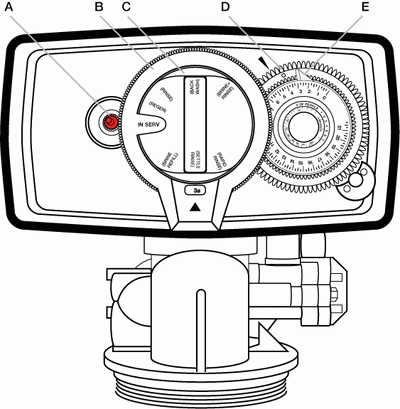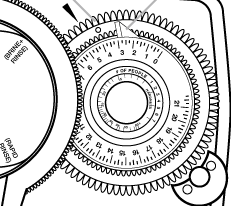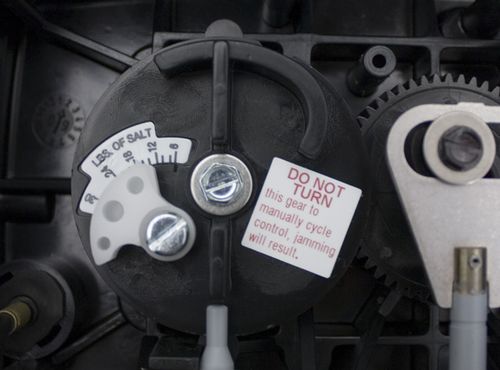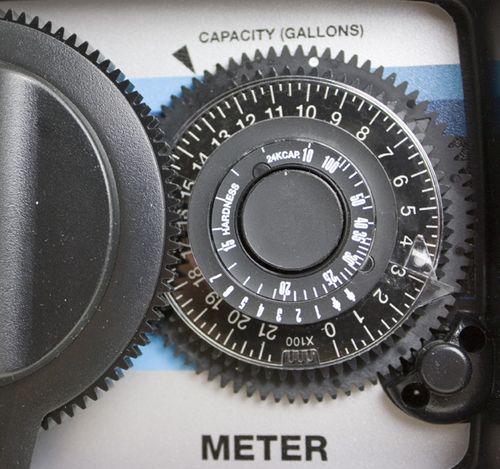How Water Softener Controls Work

Residential water softeners must on a periodic basis "regenerate" themselves by recharging their resin bed with a strong brine solution. A control valve on top of the softener initiates and controls this recharge.
Residential water softeners have two kinds of control systems. The oldest and simplest is a clock timer, often called a day clock. It works like the timer on a stove. You pre select a day for regeneration, and when the day arrives, the timer initiates and carries out the regeneration of the softener. A typical setup might be every sixth day. The softener would regenerate every sixth day regardless of the amount of water used in the home.
A metered softener counts the gallons of water that pass through the softener, then initiates the regeneration after a pre-set number of gallons of water have been processed. If little water is used, regenerations are less frequent, and vice versa.
It is generally believed that metered softeners are more economical and friendly to the environment than timer models. This is probably true in most cases.
Metered systems, however, don't automatically save water. Both timers and meters have to be set up correctly, and a poorly programmed meter is just as inefficient as a poorly set timer.
In programming a water softener, certain assumptions (guesses) are made. The most basic is that a person living in a residence uses 75 gallons of water per day. Some manufacturers attempt to be more scientific and move the figure up or down a bit, but the basic guess is that a person uses 75 gallons of residential water per day. That number usually works pretty well.
To set the softener up correctly it is also necessary to know the hardness of the water. Hardness is a measure of the calcium and magnesium present in the water. It is expressed either in parts per million or, more commonly, in grains per gallon. A "grain" equals 17.1 parts per million. It is also important to know the iron and manganese content of the water. Iron and manganese are frequently issues with well water, but they are rare in city water supplies.
For the sake of simplicity, this discussion assumes there is no iron or manganese in the water. The presence of iron and/or manganese presents another set of issues.
To attempt to set the softener control without knowing the hardness of your water is as pointless a setting your watch without knowing what time it is. Fortunately, it is easy to test for hardness with inexpensive tests available in pool stores, pet stores, hardware stores, and many other places. Or, if you live in a city, simply call your city water department and they'll tell you. They may give you a hardness level in milligrams per liter. To convent to grains per gallon, which is what's used in water treatment jargon, divide the milligrams per liter by 17.1. A grain of hardness is equal to 17.1 milligrams per liter or 17.1 parts per million.
Once you know the hardness of the water and the number of people who live in your home (if you can't remember, ask a member of your family), you're ready to program the softener.

What you're trying to do is
A. Determine how many gallons of water your softener will soften before it needs to recharge itself, and
B. Give the softener the information it needs to recharge itself just a bit before it reaches its capacity.
Determining the gallon capacity
Your softener has a theoretical capacity, or "size," that is stated in grains. For example, if you have a "40,000 grain softener," it will in theory treat 40,000 grains of hardness between regenerations. If your water has 20 grains of hardness per gallon, your softener will treat 40,000 grains divided by 20, or 2,000 gallons of water between regenerations. If your family uses 500 gallons of water per day, the softener needs to regenerate approximately every fourth day. 2,000 divided by 500.
The example above is only theoretical because a regenerated softener has less capacity than its stated capacity and the real capacity depends on how much salt is used to recharge it. The more salt, the greater the capacity. The 40,000 gallon figure is based on your giving the softener its strongest salt dose, which is an impractically high amount. 15 lbs. of salt per cubic foot of softener resin is the largest practical salt dosage, and that will actually only regenerate the 40,000 grain softener to about 37,500 grains capacity.
Here are the most common sizes of residential water softeners with the information needed to program the control valve for optimal performance. You will note that as less salt is used for regeneration, the softener's treatment capacity decreases, but its efficiency in terms of salt usage goes up at a greater rate.
| Common Size Designation in Grains | Mineral Tank Size | Cubic Feet of Resin in the Mineral Tank | Actual softening capacity if dosed with 6 lbs salt per cubic foot of resin | Actual softening capacity if dosed with 10 lbs salt per cubic foot of resin | Actual softening capacity if dosed with 15 lbs salt per cubic foot of resin |
| 15,000 | 7" X 44" | 0.5 | 10,000 | 12,500 | 15,000 |
| 24,000 | 8" X 44" | 0.75 | 15,000 | 18,750 | 22,500 |
| 32,000 | 9" X 48" | 1.0 | 20,000 | 25,000 | 30,000 |
| 40,000 | 10" X 44" | 1.25 | 25,000 | 31,250 | 37,500 |
| 48,000 | 10" X 54" | 1.50 | 30,000 | 37,500 | 45,000 |
| 64,000 | 12" X 48" | 2.00 | 40,000 | 50,000 | 60,000 |
| 80,000 | 13" X 54" | 2.50 | 50,000 | 62,500 | 75,000 |
| 110,000 | 14" X 65" | 3.50 | 70,000 | 87,500 | 105,000 |
Let's use another example to show how the table works.
We'll say your water hardness is 15 grains per gallon and you have a family of 3. You have a 24,000 grain water softener.
Your family of three will use 225 gallons of water per day (3 X 75). Since the water has 15 grains of hardness, you'll need to treat 3375 grains of hardness per day (225 X 15). If you give the softener its full dose of salt, 15 lbs. per cubic foot, you can go about 6 2/3 days before regenerating (22,500/3375). Dosing at 10 lbs., the softener can go 5 1/2 days (18,750/3375). At 6 lbs. per cubic foot, you'll have to regenerate every 4 1/2 days (15,000/3375).
Now, take a look at salt usage.
We'll use the 32,000 grain softener since it has exactly 1 cubic foot of resin.
Note that it yields 30,000 grains of softening while using the full 15-lbs. of salt. It gives a 25,000 grain performance while using 10 lbs. of salt, and a 20,000 grain performance on only 6 lbs. In other words, as compared with full salting, you get 2/3 as much softening performance on 2/5 as much salt at 6 lbs., and 5/6 the performance for only 2/3 the salt at 10 lbs. In a month's time, you'll use several pounds less salt by reducing the salt dosage. However, since the softener will have to regenerate more frequently, you'll use more water.
I'm not going to try to tell you where to set your salt dosage, but in many cases the middle ground works best, giving you good salt economy without excessive water.
Reserve
One more thing to consider before we set your softener up is reserve. Since your softener will regenerate at 2:00 AM, you need to leave it a bit of leeway so you won't run out of softened water at noon. The easy way to do this is just subtract a day's "reserve" from your calculated total. If you have a family of four, for example, subtract 300 gallons from the capacity (75 for each person in the family).
To set up your softener valve, here's what you need to know:
A. The salt setting. Pick a number. We suggest starting with 10 lbs. You can change later if you feel a different setting is needed. Multiply 10 times the cubic feet of resin in your softener. The result is your salt setting.
B. Determine the capacity. Take the number from the chart for your softener size under the 10-pound column. This is in total grains, so to convert it to gallons capacity, divide it by the number of grains of hardness of your water. Finally, from this subtract the reserve--the number of people living in the home multiplied by 75. The answer is the gallons capacity of your softener between regenerations.
To put this information into a day clock softener, just set the salt setting (see below), then divide your daily consumption, in grains, into the total grain capacity of your softener, then set up the time clock so that it will regenerate when the capacity is exhausted. Let's say your softener has a batch capacity of 15,000 grains and you have a family of four and your water is ten grains per gallon hard. Four times 75 equals 300 gallons per day time ten grains equals 3,000 grains per day. Then, 3,000 into 15,000 tells you that the softener should regenerate every fifth day. Since most day clocks are 12 day clocks, the closest you can get is every fourth day. This isn't a very exact science, and that's a reason that you can often be more exact with a metered softener.
To program the salt setting on your Fleck Econominder metered softener, take the back cover off of the valve and look inside. To your left you'll see the salt setting indicator shown in the picture below. Just loosen the screw, move the indicator arrow to the salt setting you determined in step A above, then retighten the screw, and replace the cover. The salt setting is done. Remember that you are setting the pounds of salt per cubic foot of resin in the softener. For a six pound setting in a softener that has two cubic feet of resin, set the dial to 12 pounds.

. The next step is to program the capacity that you determined in step B into the softener. This is an easy process. Find the capacity wheel on the face of the control module (see picture below). Set the white dot on the outer wheel against the capacity of your softener. The capacity numbers are multiplied by 100. The picture shows a setting of 1000 gallons. The setting doesn't have to be exact--just get as close to your capacity number as possible.
Note: This step is sometimes tedious because moving the gears is more difficult with some valves than others. The best way is to use your thumb and forefinger to pull out on the "people wheel" (the wheel just inside the transparent capacity wheel, the one with little people on it) while you hold the outermost wheel down with the thumb of your other hand. In this way you can move the wheels to match them up. Just mess with it. You'll figure it out.

The final step is setting the time of day. Do this with red button on the left. (See the top picture on this page.) Set it to the real time of day--the time when you set the time--and the softener will regenerate at 2:00 AM of the appropriate day.
Electronic Control Setup
Metered SXT units come with good programming instructions. It's worth your trouble to give some consideration to setup, because you have lots of options that can improve performance.
Unless your softener has been set up specifically for you by the vendor, don't assume that the default settings are good enough. There is no reason to have a sophisticated softener control if it's set up incorrectly.